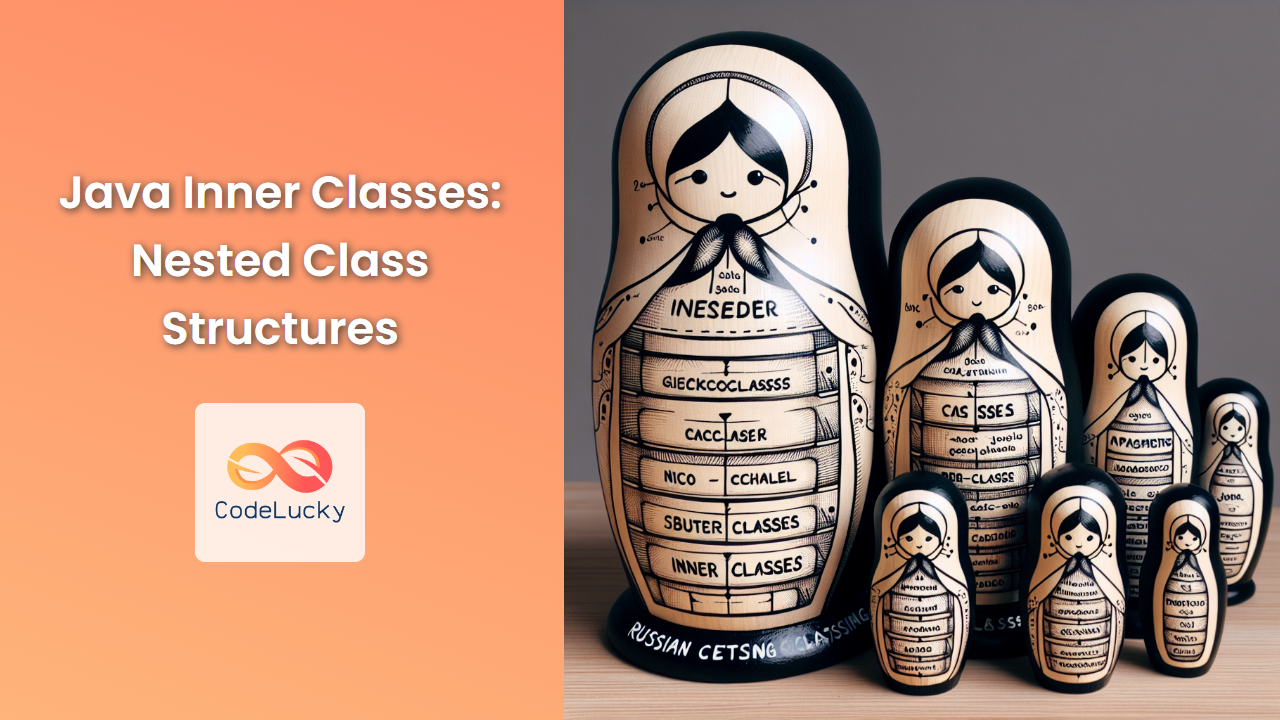Java, a versatile and powerful programming language, offers developers a unique feature known as inner classes. These nested class structures provide a way to logically group classes that are only used in one place, increasing encapsulation, and creating more readable and maintainable code. In this comprehensive guide, we'll dive deep into the world of Java inner classes, exploring their types, benefits, and practical applications.
Understanding Inner Classes
Inner classes, also known as nested classes, are classes defined within other classes. They represent a special type of relationship where the inner class is a member of its enclosing class and has access to all of its members, even those declared as private.
🔑 Key Point: Inner classes can access private members of the outer class, promoting better encapsulation.
There are four types of inner classes in Java:
- Static Nested Classes
- Non-static Nested Classes (Inner Classes)
- Local Classes
- Anonymous Classes
Let's explore each type in detail with practical examples.
1. Static Nested Classes
Static nested classes are the simplest form of inner classes. They are declared as static members of the outer class and behave similarly to top-level classes.
Characteristics of Static Nested Classes:
- Declared using the
statickeyword - Can access only static members of the outer class
- Can be instantiated without an instance of the outer class
Let's look at an example:
public class OuterClass {
private static int outerStaticField = 10;
private int outerInstanceField = 20;
public static class StaticNestedClass {
public void display() {
System.out.println("Outer static field: " + outerStaticField);
// Cannot access outerInstanceField directly
}
}
}
// Usage
OuterClass.StaticNestedClass nestedObject = new OuterClass.StaticNestedClass();
nestedObject.display();
In this example, StaticNestedClass can access outerStaticField but not outerInstanceField.
🔍 Pro Tip: Use static nested classes when the nested class doesn't need access to the instance members of the outer class.
2. Non-static Nested Classes (Inner Classes)
Non-static nested classes, often simply called inner classes, are the most common type of nested classes. They have full access to the members of the enclosing class, including private members.
Characteristics of Inner Classes:
- Do not have the
statickeyword in their declaration - Can access both static and non-static members of the outer class
- Require an instance of the outer class to be created
Here's an example:
public class OuterClass {
private int outerField = 10;
public class InnerClass {
public void display() {
System.out.println("Outer field: " + outerField);
}
}
public void createInner() {
InnerClass inner = new InnerClass();
inner.display();
}
}
// Usage
OuterClass outer = new OuterClass();
OuterClass.InnerClass inner = outer.new InnerClass();
inner.display();
In this example, InnerClass can access outerField directly.
💡 Insight: Inner classes are particularly useful for implementing helper classes that are tightly coupled with the outer class.
3. Local Classes
Local classes are classes defined within a method or a scope block. They have access to all members of the enclosing class and can also access local variables if they are declared final or effectively final.
Characteristics of Local Classes:
- Defined within a method or scope block
- Can access all members of the enclosing class
- Can access local variables if they are final or effectively final
Here's an example:
public class OuterClass {
private int outerField = 10;
public void someMethod() {
final int localVar = 20;
class LocalClass {
public void display() {
System.out.println("Outer field: " + outerField);
System.out.println("Local variable: " + localVar);
}
}
LocalClass local = new LocalClass();
local.display();
}
}
// Usage
OuterClass outer = new OuterClass();
outer.someMethod();
In this example, LocalClass can access both outerField and localVar.
🎯 Best Practice: Use local classes when you need a class for a very specific purpose within a single method.
4. Anonymous Classes
Anonymous classes are perhaps the most intriguing type of inner classes. They are classes defined and instantiated in a single expression, without a name.
Characteristics of Anonymous Classes:
- Defined and instantiated in a single expression
- Can implement an interface or extend a class
- Often used for one-time use classes
Here's an example:
public interface Greeting {
void greet();
}
public class AnonymousClassExample {
public void sayHello() {
Greeting englishGreeting = new Greeting() {
@Override
public void greet() {
System.out.println("Hello!");
}
};
englishGreeting.greet();
}
}
// Usage
AnonymousClassExample example = new AnonymousClassExample();
example.sayHello();
In this example, we create an anonymous class that implements the Greeting interface.
🚀 Advanced Tip: With the introduction of lambda expressions in Java 8, many use cases for anonymous classes can now be replaced with more concise lambda expressions.
Benefits of Using Inner Classes
Inner classes offer several advantages:
-
Encapsulation: Inner classes can access private members of the outer class, allowing for better encapsulation.
-
Readability and Maintainability: By nesting classes, you can keep related code together, improving code organization.
-
Callback Implementation: Inner classes are often used to implement callbacks, especially in GUI programming.
-
Improved Code Flexibility: Inner classes provide a way to extend a class or implement an interface in a very localized manner.
Practical Applications of Inner Classes
Let's explore some real-world scenarios where inner classes shine:
1. Event Handling in GUI Applications
Inner classes are commonly used in GUI programming for event handling. Here's an example using Java Swing:
import javax.swing.*;
import java.awt.event.*;
public class ButtonExample {
private JFrame frame;
private JButton button;
public ButtonExample() {
frame = new JFrame("Button Example");
button = new JButton("Click Me");
button.addActionListener(new ActionListener() {
@Override
public void actionPerformed(ActionEvent e) {
JOptionPane.showMessageDialog(frame, "Button Clicked!");
}
});
frame.add(button);
frame.setSize(300, 200);
frame.setVisible(true);
}
public static void main(String[] args) {
new ButtonExample();
}
}
In this example, we use an anonymous inner class to implement the ActionListener interface for button click handling.
2. Iterator Implementation
Inner classes are often used to implement iterators for custom collections. Here's an example:
import java.util.Iterator;
public class CustomList<T> implements Iterable<T> {
private T[] elements;
private int size;
@SuppressWarnings("unchecked")
public CustomList(int capacity) {
elements = (T[]) new Object[capacity];
size = 0;
}
public void add(T element) {
if (size < elements.length) {
elements[size++] = element;
}
}
@Override
public Iterator<T> iterator() {
return new CustomIterator();
}
private class CustomIterator implements Iterator<T> {
private int currentIndex = 0;
@Override
public boolean hasNext() {
return currentIndex < size;
}
@Override
public T next() {
return elements[currentIndex++];
}
}
public static void main(String[] args) {
CustomList<String> list = new CustomList<>(3);
list.add("Apple");
list.add("Banana");
list.add("Cherry");
for (String fruit : list) {
System.out.println(fruit);
}
}
}
In this example, we use a non-static inner class CustomIterator to implement the Iterator interface for our CustomList class.
Best Practices and Considerations
When working with inner classes, keep these best practices in mind:
-
Use static nested classes when the nested class doesn't need access to instance members of the outer class.
-
Prefer non-static inner classes when you need access to both static and non-static members of the outer class.
-
Use local classes for very specific, localized functionality within a method.
-
Consider anonymous classes for one-time use implementations of interfaces or abstract classes.
-
Be aware of the implicit reference to the outer class instance in non-static inner classes, which can prevent garbage collection of the outer instance.
-
Use lambda expressions instead of anonymous classes for functional interfaces (interfaces with a single abstract method) when possible.
Conclusion
Java inner classes provide a powerful mechanism for creating more organized, encapsulated, and flexible code. By understanding the different types of inner classes and their appropriate use cases, you can leverage this feature to write cleaner, more maintainable Java applications.
Whether you're handling events in a GUI application, implementing iterators for custom collections, or simply organizing related classes, inner classes offer a versatile solution. As you continue to explore Java programming, remember that mastering inner classes can significantly enhance your ability to design elegant and efficient code structures.
Happy coding! 🖥️👨💻👩💻



















